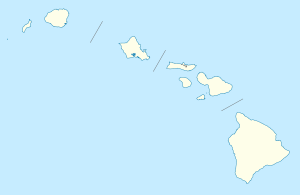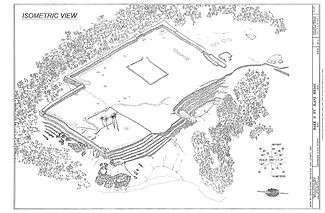Kahanu Garden
Kahanu Garden and Preserve is a botanical garden located on the Hāna Highway (close to the 31-mile or 50-kilometre marker) near Hāna, Maui, Hawaiʻi. It is one of five gardens of the non-profit National Tropical Botanical Garden, the others being McBryde, Allerton, and Limahuli Garden and Preserve on Kauaʻi, and The Kampong in Florida.[1]
The garden was established in 1972 on Maui's northern coast, with rugged black lava seascapes, and is surrounded by one of Hawaiʻi's last undisturbed hala (Pandanus tectorius) forests.
The garden's ethnobotanical collections focus on plants traditionally used by Pacific Island people. It includes the world's largest breadfruit collection, first established in the 1970s. Today the garden contains accessions of approximately 150 varieties of breadfruit collected from field expeditions to over 17 Pacific island groups in Polynesia, Micronesia, and Melanesia, as well as Indonesia, the Philippines, and the Seychelles. This collection is used for research and conservation by NTBG’s Breadfruit Institute.
Other garden holdings include bamboo, banana, calabash, coconut, kava, kamani (Calophyllum inophyllum), loʻulu (Pritchardia arecina), sugarcane, taro, turmeric, vanilla, and bitter yam (Dioscorea bulbifera).
Kahanu Garden is open to visitors. An admission fee is charged.[2]
Piʻilanihale Heiau
|
Piilanihale Heiau | |
|
Sketch of the heiau | |
 | |
| Nearest city | Hāna, Hawaiʻi |
|---|---|
| Coordinates | 20°47′57″N 156°2′18″W / 20.79917°N 156.03833°WCoordinates: 20°47′57″N 156°2′18″W / 20.79917°N 156.03833°W |
| Area | 3 acres (12,000 m2) |
| NRHP Reference # | 66000300 |
| Significant dates | |
| Added to NRHP | October 15, 1966[3] |
| Designated NHL | January 29, 1964[4] |
Kahanu Garden also contains the 3-acre (12,000 m2) Piʻilanihale Heiau, a National Historic Landmark believed to be the largest ancient temple in the Hawaiian Islands. It is built from basalt blocks and extends 341 feet (104 m) by 415 feet (126 m), with a high front wall rising 50 feet (15 m). The large central terrace with two separate platforms is situated on a broad ridge that adds to its majesty. The side facing the sea rises steeply in five stepped terraces, and the upper rectangular surface of the main platform contains several smaller walled enclosures and pits, all bounded on the rear by a well-built stone wall up to 8 feet (2.4 m) high.[5]
Construction of the main terrace dates back to the 14th century. Wings were later added and rededicated during the 16th century, possibly after high chief Piʻilani from western Maui conquered the fertile, well-watered, and heavily populated Hāna region, thereby unifying the whole island.[5]
- gardens below heiau
- ocean side of heiau wall
- closer view of heiau wall
- canoe house enclosure
- thatched canoe house
- outrigger canoe in canoe house
- Hale Hoʻokipa ('Welcome House')
- whetstone near Hale Hoʻokipa
See also
References
- ↑ "Our Gardens - National Tropical Botanical Garden". Retrieved 2010-04-08.
- ↑ "Tour the Garden - National Tropical Botanical Garden: Kahanu Garden". Retrieved 2010-04-08.
- ↑ National Park Service (2007-01-23). "National Register Information System". National Register of Historic Places. National Park Service.
- ↑ "Piilanihale Heiau". National Historic Landmark summary listing. National Park Service. Retrieved 2008-07-04.
- 1 2 Kirch, Patrick Vinton (1996). "Piʻilanihale Heiau". Legacy of the Landscape: An Illustrated Guide to Hawaiian Archaeological Sites. Honolulu: University of Hawaii Press. pp. 72–74. ISBN 0-8248-1739-7.
External links
| Wikimedia Commons has media related to Piʻilanihale Heiau. |
